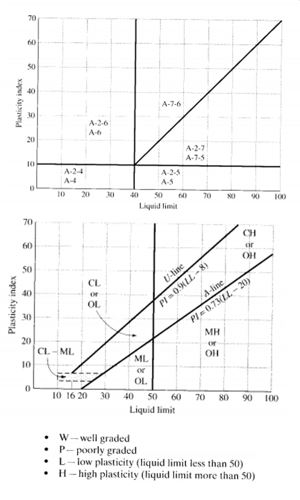
EVERYTHING* YOU WANTED TO KNOW ABOUT SOILS, BUT WERE AFRAID TO ASK
*Not Quite Everything**
**More of a Refresher
What exactly is liquid limit? What does plasticity actually mean? What’s the cut-off between a gravel and a sand?
We can pretty much blame three people for the majority of the soil classification terminology used in civil engineering today: a Swedish fellow named Albert Atterberg, and two Austrian-Americans named Karl von Terzaghi and Arthur Casagrande.
Back in the beginning of the twentieth century, Atterberg had this crazy idea to investigate soil grain sizes and their consistency limits for agricultural uses. He developed a test to determine whether the fine particles of a soil exhibited semi-solid, plastic, or liquid behavior. His test for plasticity was a rather simple one. Take a piece of soil, roll it into a thin string, and see if it cracks. If it doesn’t crack, re-roll it. Each time it’s re-rolled it will lose water due to evaporation. The point at which the string of soil cracks when it’s an eighth of an inch in diameter is its plasticity limit. Soil that can’t be rolled down into a thin string, no matter its moisture content, is considered non-plastic.
Atterberg’s test for determining a clay soil’s liquid limit was pretty simplistic as well: mix a sample of clay into a small porcelain bowl, cut a groove in the clay with a spatula, and smack the bottom of the bowl with the palm of your hand until the groove closes in. It turns out Attenberg’s research gained virtually no traction in agricultural applications, but turned out to be quite useful in the study of soil mechanics. Casagrande refined the liquid limit test to make it more repeatable. He introduced a standard brass cup that is struck against a rubber base, instead of smacking a porcelain bowl against the palm of your hand. And he also developed a standard cutting tool to carve a groove in the clay paste instead of using a spatula.
In 1929, Terzaghi assisted in classifying soils for highway construction purposes and in 1942, Casagrande developed a soil classification system for the use of airfield construction being undertaken by the Army Corps of Engineers. The soil groupings are both based on the soil’s particle size, and plasticity. Terzaghi’s soil classification became the AASHTO soil classification system, and Casagrande’s became the Unified Soil Classification System (USCS). Since Casagrande worked as Terzaghi’s assistant at MIT, their soil classifications were fairly similar. AASHTO considers a soil to be fine grained when more than 35% of the soil passes through the No. 200 sieve, the USCS system considers a soil fine grained if more than 50% passes through the No. 200 sieve. In the USCS gravels are between the 3” and #4 sieve, sands are between the #4 and #200 sieve; in AASHTO gravels are between the 3” and #10 sieve, sands are between the #10 and #200 sieve. The USCS system classifies organic soils, whereas the AASHTO system does not. Luckily for us, Thomas Liu developed a Rosetta stone in 1967, comparing the AASHTO and USCS classifications. I happened to include his findings below, you’re welcome.


